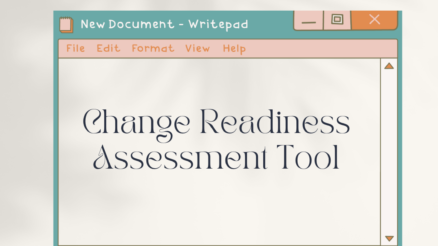Change management is a strategic process that helps organizations navigate through the transition and implement new ideas, processes, and systems.
One way to measure an organization’s change management effectiveness is by assessing its change management maturity level.
The Change Management Maturity Model is a framework that identifies five levels of maturity: Ad Hoc, Isolated Project, Multiple Project, Organizational Structure, and Organizational Competence.
Each level represents a different stage in the development of change management capabilities within an organization. Understanding the maturity level of your organization can help you identify areas for improvement and develop a plan to move to the next level.
In this blog post, we will be exploring the five levels of the Change Management Maturity Model in detail, highlighting the characteristics and examples of organizations at each level and the challenges and limitations of each level.
Definition of Change Management Maturity
Change management maturity refers to the level of capability and effectiveness of an organization’s change management processes and practices. It is a measure of how well an organization can plan for, execute, and sustain changes in a way that minimizes disruptions and maximizes benefits.
A mature change management system is well-established, consistently applied, and continuously improved upon. Change management maturity is important because it helps organizations to effectively manage changes and achieve their desired outcomes.
When an organization has a high level of change management maturity, it is better equipped to navigate changes and minimize disruptions to business operations. This can result in increased efficiency and productivity, improved employee engagement and satisfaction, and a greater ability to achieve strategic goals.
5 Levels of Change Management Maturity
Here are five levels of change management maturity:
Level 1: Ad Hoc
Organizations at the Ad Hoc level of change management maturity have little to no formal change management processes in place. They tend to react to change on an as-needed basis and lack a clear understanding of how to manage change effectively.
Small businesses with minimal structure, individual teams or departments within larger organizations are classic examples of this level of change management maturity.
Organizations at this level may struggle with communication, lack of buy-in, and resistance to change. They may also have difficulty managing multiple changes at once and lack the ability to measure the success of their change management efforts.
Change Management practices at this level are ad-hoc, uncoordinated and reactive, meaning that change management is not a planned or systematic process in the organization, and it’s done on an as-needed basis and the organization reacts to changes rather than proactively manage them.
Level 2: Isolated Project
Organizations at the Isolated Project level have some basic change management processes in place, but they are only applied to individual projects and not integrated into the overall organizational structure. They may have a designated change management leader or team, but their efforts are limited to a single project.
Organizations at this level may struggle with consistency across multiple projects, lack of communication and coordination between different teams or departments, and difficulty measuring the success of change management efforts.
Change Management practices at this level are project-specific and limited to a single project, meaning that change management processes are only applied to one specific project and not integrated into the organization’s overall structure. This can lead to inconsistency in change management practices across different projects.
Level 3: Multiple Project
Organizations at the Multiple Project level have established change management processes in place, but they are not fully integrated into the organization’s structure. Change management efforts are consistent across multiple projects, but there is limited coordination between different teams and departments. They may have a designated change management leader or team, and some measurement and monitoring of change management efforts is in place.
Organizations at this level may struggle with coordination and communication between different teams and departments, and may lack a clear understanding of the overall impact of change management efforts on the organization as a whole.
Change Management practices at this level are consistent across multiple projects, but not fully integrated into the organization’s structure, meaning that change management processes are applied to more than one project, but they are not yet fully integrated with the organization’s structure and processes. This can lead to inconsistencies in change management practices across different departments or teams.
Level 4: Organizational Structure
Organizations at the Organizational Structure level have fully integrated change management processes into their organizational structure and processes. Change management efforts are coordinated and consistent across different teams and departments. They have a designated change management leader or team, and clear measurement and monitoring of change management efforts is in place. The organization has a clear understanding of the overall impact of change management efforts on the organization as a whole.
Organizations at this level may struggle with maintaining consistency in change management practices as the organization and its structure evolves, and may also struggle with effectively communicating and gaining buy-in for change management efforts from all levels of the organization.
Change Management practices at this level are integrated into the organization’s structure and processes, meaning that change management processes are fully integrated with the organization’s structure and processes, and are consistently applied across different teams and departments.
Level 5: Organizational Competence
Organizations at the Organizational Competence level have fully integrated change management into their organizational culture and competencies. Change management is not just a function or process, it is a core competency and part of the organization’s DNA. They have a mature change management function, with clear roles and responsibilities, and a consistent approach to change management across the entire organization. The organization regularly assesses and improves their change management maturity level and continuously adapts to the changing environment.
Organizations at this level may struggle with effectively communicating and gaining buy-in for change management efforts from all levels of the organization, and may also struggle with maintaining consistency in change management practices as the organization and its structure evolves.
Change Management practices at this level are fully integrated and continuously improved as part of the organization’s culture and competencies, meaning that change management is not just a process or function but it’s embedded in the organization’s culture and competencies, and it’s continuously improved and adapted to the changing environment.
Benefits of using 5 levels of change management maturity model
Identifying current level of maturity: The five levels of change management maturity model provides a framework for organizations to identify their current level of change management maturity. This can help organizations understand where they stand in terms of their ability to manage change and identify areas for improvement.
Developing a plan for improvement: Once an organization has identified its current level of change management maturity, it can develop a plan for improvement by identifying the steps needed to move to the next level.
Consistency: The five levels of change management maturity model provides a consistent framework for organizations to measure their change management maturity, which can help in benchmarking and comparing the change management maturity level of different organizations.
Continual Improvement: By using the five levels of change management maturity model, organizations can continuously assess and improve their change management maturity level over time. This helps organizations stay adaptable and flexible to changing environments.
Communication and alignment: The five levels of change management maturity model helps in communicating and aligning the change management expectations and practices throughout the organization and it helps to gain buy-in from all levels of the organization.
Better decision making: By using the five levels of change management maturity model, organizations can better understand the potential impact and risks of change, and make more informed decisions about how to manage change effectively.
Better performance: By implementing best practices and continuously improving the change management maturity level, organizations can improve their performance and achieve better results in implementing change initiatives.
Final Words
The five levels of change management maturity model provides organizations with a framework for assessing and improving their change management capabilities. By identifying their current level of change management maturity, organizations can develop a plan for improvement and work towards becoming more effective in managing change. It is important to note that the five levels of change management maturity model is not a one-time assessment, it is important for organizations to regularly assess their change management maturity level and adapt to the changing environment. By regularly assessing and improving their change management maturity level, organizations can improve their performance and achieve better results in implementing change initiatives.



